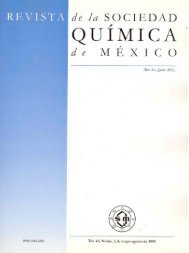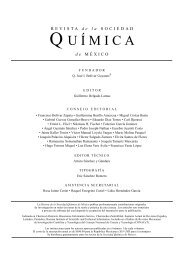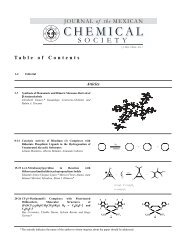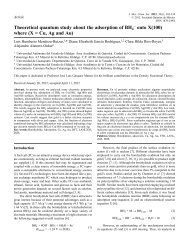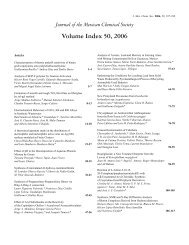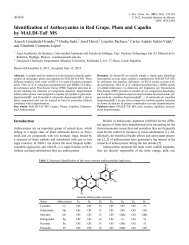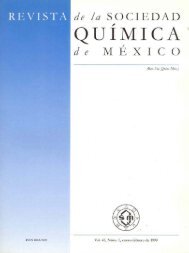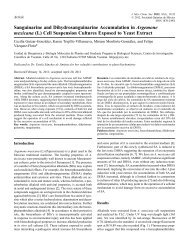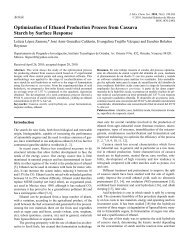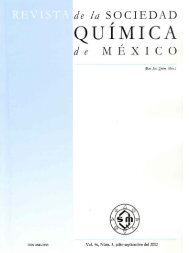SMQ-V047 N-002_ligas_size.pdf - Journal of the Mexican Chemical ...
SMQ-V047 N-002_ligas_size.pdf - Journal of the Mexican Chemical ...
SMQ-V047 N-002_ligas_size.pdf - Journal of the Mexican Chemical ...
Create successful ePaper yourself
Turn your PDF publications into a flip-book with our unique Google optimized e-Paper software.
188 Rev. Soc. Quím. Méx. Vol. 47, Núm. 2 (2003) Luis Chacón-García et al.<br />
Compounds 21-25 were examined to analyze <strong>the</strong> importance<br />
<strong>of</strong> <strong>the</strong> relative position <strong>of</strong> <strong>the</strong> amide group and <strong>the</strong> presence<br />
<strong>of</strong> branching in <strong>the</strong> aliphatic chain. Surprisingly, compound<br />
21 was <strong>the</strong> most active in <strong>the</strong> bromide series, displaying<br />
relatively good inhibition in <strong>the</strong> three cell lines. Given <strong>the</strong><br />
activity <strong>of</strong> 21, it is surprising that 22 was inactive. To complete<br />
<strong>the</strong> series <strong>of</strong> bromide compounds, 11 (n = 3, R = Br) was<br />
obtained; it showed greater activity than 7 (R = Br, n = 2) but<br />
less than 14 (R = Br, n = 4) in K562 cell line.<br />
The inhibition resulted by 21, lead to <strong>the</strong> resentment that<br />
conformation could be implicated in <strong>the</strong> cytotoxic activity. To<br />
test this idea, compounds 26 and 27 were syn<strong>the</strong><strong>size</strong>d; however,<br />
both <strong>of</strong> <strong>the</strong>se compounds were inactive. Although <strong>the</strong>se<br />
molecules are structurally similar to 21-25, <strong>the</strong> formers (26<br />
and 27) are not very capable <strong>of</strong> interacting by hydrogen bonding.<br />
This is a very important factor affecting cytotoxicity in<br />
DNA groove binders due to <strong>the</strong> stability <strong>of</strong> <strong>the</strong> DNA-ligand<br />
complex.<br />
Conclusions<br />
The data presented here are inconclusive regarding <strong>the</strong> relationship<br />
between electronic factors or hydrogen bonding capability<br />
and inhibition <strong>of</strong> <strong>the</strong> growth in tumor cell lines. The present<br />
results also show no clear link between <strong>the</strong> presence <strong>of</strong><br />
halogens or <strong>the</strong> length <strong>of</strong> <strong>the</strong> aliphatic chain and <strong>the</strong> cytotoxicity<br />
<strong>of</strong> a compound. However, this study did reveal <strong>the</strong> interesting<br />
finding that <strong>the</strong> compounds which presented cytotoxic<br />
activities were primarily those containing fluoride or bromide.<br />
Experimental<br />
Chemistry<br />
General procedure for <strong>the</strong> preparation <strong>of</strong> 6-20. Diacyl chloride<br />
(0.72 mmol) was added to a solution <strong>of</strong> 4-R-aniline (1.44<br />
mmol) in 15 mL <strong>of</strong> acetone at 5 °C. After 2 h stirring, <strong>the</strong><br />
mixture was filtered and washed with acetone to afford 6-20.<br />
12: 1 H NMR (δ, J(Hz)): 1.60 (s, 4H), 2.30 (s, 4H), 7.10 (m,<br />
4H), 7.57 (m, 4H), 9.94 (s, 2H); IR ν (cm –1 ) 1652, 3305. 15:<br />
1H NMR (δ, J(Hz)): 1.59 (s, 4H), 2.31 (s, 4H), 7.41 (d, J =<br />
8.8, 4H), 7.60 (d, J 8.7, 4H), 9.97 (s, 2H); IR ν (cm –1 ) 1657,<br />
3292. 19: 1 H NMR (δ, J(Hz)) 1.59 (m, 4H), 1.99 (s, 6H), 2.28<br />
(s, 4H), 7.46 (s, 8H), 9.80 (s, 2H), 9.83 (s, 2H); IR ν (cm –1 )<br />
1659, 3298.<br />
General procedure for <strong>the</strong> preparation <strong>of</strong> 21-23 and 25-27. 4-<br />
bromobenzoyl chloride (1 mmol) was added to a solution <strong>of</strong><br />
diamine (0.7 mmol) in 15 mL <strong>of</strong> acetone at 5 °C. After 2 h<br />
stirring, water was added and <strong>the</strong> precipitated filtered and<br />
washed with water and acetone to afford 21-23 or 25.<br />
21: 1 H NMR (δ, J(Hz)) 1.15 (d, J 6.64, 3H), 3.35 (t, J 9, 2H),<br />
4.23 (m, 1H), 7.64 (d, J 8.6, 4H), 7.76 (d, J 8.5, 2H), 8.34 (d, J<br />
8.2, 1H) 8.63 (t, J 5.6, 1H); IR ν (cm –1 ) 1637, 3301.<br />
22: 1 H NMR (δ, J(Hz)): 1.33 (s, 4H), 7.65 (d, J 8.85, 4H),<br />
7.77 (d, J 8.5, 4H), 8.67 (s, 2H); IR ν (cm –1 ) 1633, 3287. 23:<br />
1H NMR (δ, J(Hz) 3.47 (d, J=2.7, 4H), 8.07 (d, J = 8.8, 4H),<br />
8.30 (d, J 8.9, 4H), 9.00 (s, 2H); IR ν (cm –1 ) 1640-3319. 25:<br />
1H NMR (δ, J(Hz)): 1.2 (d, J 6.7, 3H), 3.45 (t, J 6.3, 2H), 4.3<br />
(m, 1H), 8.03 (d, J 8.96, 2H), 8.05 (d, J 9, 2H), 8.63 (d, J 8.14,<br />
1H), 8.92 (t, J 5.6, 1H); IR ν (cm –1 ) 1661, 3318. 26: 1 H NMR<br />
(δ, J (Hz)) 3.54 (m, 8H), 7.37 (d, J 8.4, 4H), 7.64 (d, J 8, 4H);<br />
IR ν (cm –1 ). 1635.<br />
Preparation <strong>of</strong> 24.<br />
Ethanol (10 ml), Pd/C 5% (0.046 g), Hidrazine (0.818 ml,<br />
25.9 mmol), water (0.93 ml) and 23 (756 mg, 2.59 mmol)<br />
were mixed in a bottom flask. The mixture was refluxed for<br />
2h. The resulting solid was dissolved in methanol with heat<br />
and filtered at vacuum. Methanol was eliminated up precipitation<br />
<strong>of</strong> a solid that was filtered and crystallized from<br />
methanol to afford 24. 1 H NMR (δ, J(Hz)): 3.33 (d, J 7.2, 4H),<br />
5.58 (d, J 3.18, 4H), 6.51 (d, J 8.5, 4H), 7.54 (d, J 8.5, 4H),<br />
8.12 (s, 2H); IR ν (cm –1 ) 1600, 3333, 3437.<br />
Cytotoxic Activity<br />
Tumoral cell lines were supplied by <strong>the</strong> National Cancer<br />
Institute. The cytotoxicity assays were carried out at 5000 to<br />
7500 cells / mL as reported by Skehan et al. and Monks et al<br />
using <strong>the</strong> sulforhodamine B (SRB) protein assay to estimate<br />
cell growth [17, 18]. Compounds were dissolved in DMSO<br />
which has not effect on <strong>the</strong> inhibition has shown by <strong>the</strong> control.<br />
The percentage <strong>of</strong> inhibition <strong>of</strong> <strong>the</strong> growth described for<br />
all compounds were obtained from three different experiments.<br />
The percentage growth was evaluated spectrophotometrically<br />
in a Bio kinetics reader spectrophotometer. Daunomicyne<br />
and 5-fluorouracyl were used as references. These<br />
compounds under <strong>the</strong> described conditions gave 100 % <strong>of</strong><br />
inhibition. Each experiment was made two times by gave triplicate.<br />
Acknowledgment. We thank CONACyT (32633-E) and<br />
DGAPA-UNAM (IN-211601) for financial support. We also<br />
thank M.T. Ramírez Apan for obtaining <strong>the</strong> biological data, R.<br />
Patiño, H. Rios, A. Peña, L. Velasco and J. Pérez for technical<br />
assistance. Contribution No. 1765 from Instituto de Química,<br />
UNAM.<br />
References<br />
1. Tim<strong>of</strong>eeva, O. A.; Ryabinin, V. A.; Sinyakov, A. N.; Zakharova,<br />
O. D.; Yamkovoy, V. I.; Tarrago-Litvak, L.; Litvak, S.;<br />
Nevinsky, G. A. Mol. Biol. (Moscow) 1997, 31, 359-365.<br />
2. Eliadis, A.; Phillips, D. R.; Reiss, J. A.; Skorobogaty, A. J.<br />
Chem. Soc. Chem. Commun 1988, 1049-1052.<br />
3. Martínez, R.; Cogordan, J. A.; Mancera, C.; Díaz, M. L. Fármaco<br />
2000, 55, 631-636.<br />
4. Chacón-García, L.; Martínez, R. Eur. J. Med. Chem. 2<strong>002</strong>, 37,<br />
261-266.<br />
5. For a review <strong>of</strong> Lexitropsin see: Lown, J. W. Drug Dev. Res.<br />
1996, 34, 145-183.




